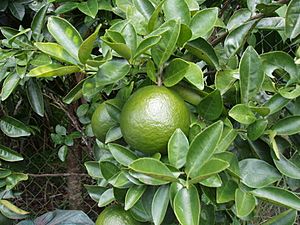Cam sành facts for kids
Quick facts for kids Cam sành |
|
|---|---|
 |
|
| A cam sành tree | |
| Scientific classification | |
| Kingdom: | |
| (unranked): | |
| (unranked): | |
| (unranked): | |
| Order: | |
| Family: | |
| Genus: | |
| Species: |
C. reticulata × sinensis
|
The Cam sành is a special type of orange, also known as the King orange. This fruit is a mix of different citrus plants, and it first came from Vietnam.
In Vietnamese, 'Cam sành' means "terracotta orange". But it looks more like a mandarin or tangerine. You can easily spot a Cam sành by its thick skin. This skin is usually bright green, but it can also be partly green and orange, or even fully orange. The fruit inside is orange, dark, and very sweet. It's the most popular orange in Vietnam and Cambodia.
What is a Cam Sành?
This tree is often called the "King Tangor" or "King Mandarin" in books about plants. You can get parts of the plant for growing from places like the University of California Citrus Clonal Protection Program. A cool fact is that in cooler places, the fruit turns a bright orange when it gets ripe.
The Cam sành is one of many citrus fruits from its home region. Other similar fruits include the yellow cam canh and the reddish-yellow cam bo ha. These are mixes of mandarin and pomelo fruits. There are also orange chun or sen, yellow bak son, and pink hong oranges. These are also "king mandarins," which are mixes of C. reticulata and C. sinensis. Plus, there are at least three types of mandarin (C. reticulata) that are not mixed with other fruits. Sometimes, the name "king mandarin" is used for the Cam sành itself.
Where Does Cam Sành Grow?
The Cam sành tree was brought to the United States in 1880. John A. Bingham, who was the United States Minister to Japan, arranged for six Cam sành fruits to be sent. They came from Saigon, which was then called Cochinchina, to a plant grower named Dr. H. S. Magee in Riverside, California. In 1882, Dr. Magee sent two young plants and some budwood to J. C. Stovin in Winter Park, Florida.
In Vietnam, people grow the tree in the Mỏ Cày District of Bến Tre Province. It also grows in the northern mountains. It used to be grown in the Bố Hạ region of Yên Thế in Bắc Giang Province. However, it was removed from there because of a plant sickness called citrus greening disease.
Today, Cam sành is widely planted in northeastern Vietnam. You can find it especially in Hà Giang, Tuyên Quang, and Yên Bái. It also grows in several provinces of the Mekong Delta in the south. These include Vĩnh Long, Cần Thơ, and Tiền Giang.
How to Grow Cam Sành
Cam sành trees prefer soil that is rich and moist, like alluvial soil. They also like a cool, damp climate. However, they can grow well in many different places, even at high altitudes. These trees produce a lot of fruit. Each fruit usually weighs between 150 and 250 grams.

